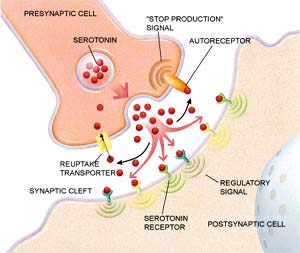



This Jmol Exploration was created using the Jmol Exploration Webpage Creator from the MSOE Center for BioMolecular Modeling.

Serotonin (5-HT) is a neurotransmitter produced in the brain. Also known as 5- Hydroxytryptamine. Found in gastrointestinal tract and blood stream. Plays an important part in the biochemistry of depression, bipolar disorder, and anxiety. Serotonin can affect the functioning of cardiovascular system, muscles, the endocrine system. Serotonin - a chemical manifestation of personality.
High level of serotonin: obsessive-compulsive disorders.
Low levels of serotonin: depression, suicide
Chemical Symbol: C10H12N2O
Serotonin is believed to play a central role in modulation of - Vasoconstriction, Anger, Aggression, Body temperature, Mood, Sleep, Sexual desire, Appetite.
When we have enough Serotonin we have: Emotional stability, Reduces aggression, Sensory input, Sleep cycle, Appetite control,
Serotonin Deficiencies result in: Irritability, Irrational emotions, Sudden unexplained tears, Sleep disturbances
Optimum serotonin level are also supposed to have positive impact on learning and cognition.
Sources:
The serotonin is found abundantly in gut and blood plasma, but it can not enter the brain.
Meat and banana are the direct sources of serotonin.
The main source of serotonin is L-tryptophan, an amino acid, which is found in proteins. So proteins are the main sources of serotonin: meat, eggs, milk, fishes
Enough calcium, magnesium and oxygen are also needed for serotonin production.
Besides these vitamin B6 also promotes its production.

Serotonin transporter is a protein (a molecule) that controls the levels of the brain chemical, serotonin. This protein determines the amount of serotonin that is available between communicating cells in the brain called neurons. Genes, which are parts of DNA that encode for proteins, can influence the serotonin transporter protein.The serotonin transporter removes serotonin from the synaptic cleft back into the synaptic boutons. Thus, it terminates the effects of serotonin and simultaneously enables its reuse by the presynaptic neuron.
Neurons communicate by using chemical messengers like serotonin between cells. The transporter protein, by recycling serotonin, regulates its concentration in a gap, or synapse, and thus its effects on a receiving neurons receptors.
Medical studies have shown that changes in serotonin transporter metabolism appear to be associated with many different phenomena, including alcoholism, clinical depression, obsessive-compulsive disorder (OCD), romantic love, hypertension and generalized social phobia
Leucine transporter is the plasma membrane transporter.
Its structure helps to show its function as a plasma membrane protein where it can transfer stuff( such as serotonin) in and out the membrane
Secondary structure: 73% helical (29 helices; 377 residues)
Alpha helixSecondary structure: 1% beta sheet (4 strands; 6 residues)"
Beta sheetMost of the structure is hydrophobic especially the majority of the middle part of structure.
Since this is placed inside the membrane protein, it has to bind with the hydrophobic environment.
Serotonin transporter is the target of many antidepressant medications.
Mechanism of action-Primary aim in treatment of depression: balance level of neurotransmitter to boost mood. SSRI's act on serotonin transporter: block reuptake of serotonin in pre-synaptic neuron, more serotonin persists in the synaptic cleft. Balancing of serotonin helps brain cells send and receive chemical messages which in turn boost mood."
The SSRI halogens all bind to exactly the same pocket within LeuT. This is called a halogen pocket because of the chloride ion that plays an essential role in the mechanism.
The binding site is the important part of leucine transporter which serotonin bind with and also where the inhibitor bind with
LeucineThe SSRI halogens (red) binds to LeuT (blue).
Binding to leucine pocketOne example of leucine transporter inhibitor: SRE (drug)
SRE SpacefillMechanism of serotonin
The serotonin transporter first binds a sodium ion, followed by serotonin, and then a chloride ion. (This is why it's called the halogen pocket) The transporter then flips inside the cell, releasing serotonin. A potassium ion binds, and the transporter flips back out, ready to receive another serotonin molecule.
Leucine transporter interact with Na ion through salt bridges (interaction between oxygen molecule in the leucine transporter and sodium ion).
Leucine stranporter binding with sodium ionThe SRE interacts with leucine transporter through interparticle forces, including hydrogen bonding (between SRE 801's hydrogen and ASP 404's oxygen)